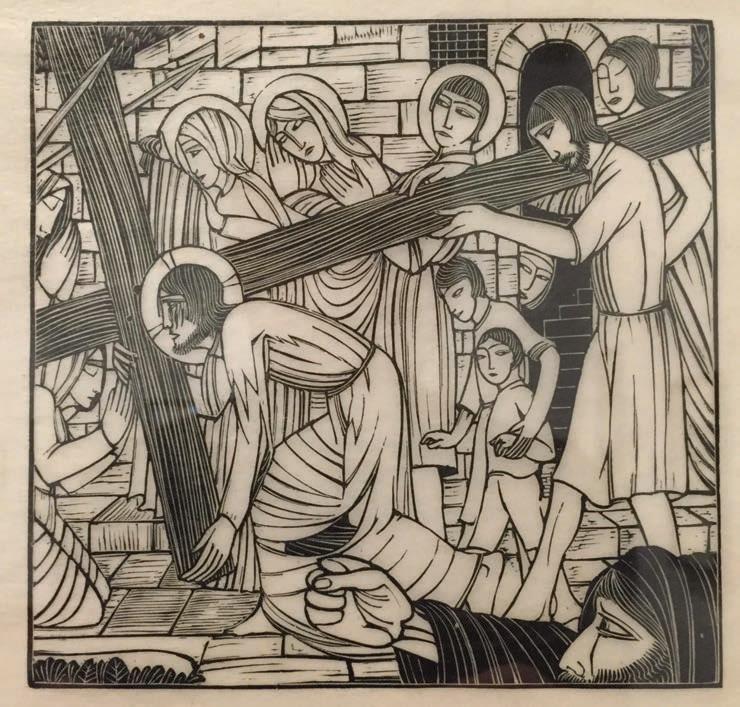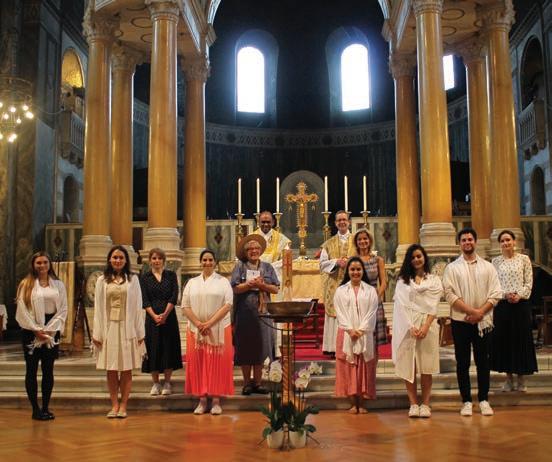
7 minute read
17
The Stations and the Apse
Patrick Rogers
Quite a number of visitors to the Cathedral know that the Stations of the Cross here were produced by Eric Gill. Some also know that he carved the altarpiece in St George’s Chapel. But very few indeed know of the other work he did for the Cathedral.
The Stations of the Cross
Eric Gill was 31 and had been a sculptor for just three years when, in August 1913, he was approached by John Marshall, the architect-incharge at the Cathedral. By this time the donors of the Stations of the Cross (who had paid for them in 1909) and Cardinal Bourne were getting increasingly impatient at their nonappearance, 10 years after the opening of the Cathedral. In April 1914 Gill produced a 9-inch square design (now in the British Museum) for the Stations which was approved by Bourne in May. The 14 panels, each 5ft 8in square, were to be carved in low relief in Hopton Wood limestone for the very low price of £765.
At this time Gill was almost unknown as a sculptor and extremely anxious to get such an important commission – hence the price. Even before his designs were accepted he had produced at his own expense a sample 4ft 6in version of the Fifth Station (Christ with Simon of Cyrene) and put it up in the Cathedral. Once commissioned he set to work at once, producing the Tenth Station (Christ is stripped of his garments), for which he used himself as a model, and the Second (Christ receives the Cross) by November 1914. Then followed the Thirteenth (Christ is taken down from the Cross) and the First (Christ is condemned to death) by June 1915, the panels being carved in the studio with the final touches being added by Gill in the Cathedral.
First reactions were unfavourable. Gill himself was unhappy with the Tenth Station and Marshall’s response to it was that it showed Gill’s style was ‘neither suitable for the peculiar light of the Cathedral nor the Catholic
Gill's sketch for the Tenth Station, Jesus is stripped of his garments (1914) public’ – to which Gill’s advice was to cover it with a sheet and wait. By June 1915 the first four Stations were on view and then the letters started, first to The Universe and then to The Observer. On the one hand the Stations were variously described as ‘grotesque and undevotional’, as ‘cold as the mind that produced them’, as hideous, primitive and pagan. On the other they were seen as ‘dignified in conception, superb in outline and restrained in feeling’ and as showing ‘admirable breadth and simplicity of design’.
In his autobiography Gill writes: ‘there were sufficient people to tell him (Cardinal Bourne) the things were good to outweigh those who said they were bad – especially when you take into account the infernal business of taking all the panels down again’ – a pretty broad hint that Bourne himself was not over-keen on them. So he continued to carve. The first four were followed were followed by the Fifth, Fourth, Third and Sixth by the end of 1916, then the Seventh and Eighth in 1917 and finally the Ninth, Twelfth, Fourteenth and Eleventh (the last being recarved at Marshall’s request) by Good Friday 1918, when they were dedicated. As shown by his sketches in the Victoria and Albert Museum, Gill continued to use himself as a model – for the lefthand soldier in the Second and Christ’s hands in the Third, while Our Lady’s hands in the Fourth are those of his wife, Ethel Mary.
Gill’s retrospective view of the Stations is characteristic. He wrote: ‘I really was the boy for the job, because I not only had a proper Christian enthusiasm, but I had sufficient, if only just sufficient, technical ability combined with a complete and genuine ignorance of art-school anatomy and traditional academic style’. He had become a Catholic just six months before he was approached about the Stations – indeed, this was one of the reasons he got the job. For him they
were both a statement of personal belief and church furniture produced for his fellow Catholic as a focus for prayer – ‘a statement without adjectives’. The figures are impassive and are meant to be so, for the emotion must come from us.
The Apse Mosaics
A stonecarver, wood-engraver, typographer and writer, Gill had no experience of mosaics. It is therefore surprising that his mosaic designs for the Cathedral sanctuary arch and dome behind it were very nearly adopted. After finishing the Stations of the Cross in 1918, Gill was given no more commissions by Cardinal Bourne, who was less than happy with the Stations. When Arthur Hinsley succeeded Bourne as Archbishop of Westminster in early 1935, Gill was persuaded to sign a memorandum from leaders of the art world criticising the recent mosaic decoration of the Cathedral – of the Lady Chapel, sanctuary arch and dome above the choir – all commissioned by Bourne and designed by Gilbert Pownall. As a result, Hinsley set up a Cathedral Art Committee to advise him.
Initially Gill’s relations with Hinsley were inauspicious. The latter had found the memorandum an embarrassment, particularly when it was released to the press in December 1935. Gill’s open support for Communist front organisations such as the Left Review and Artists International was an added embarrassment in view of Pope Pius XII’s directive to avoid association with such bodies and Gill’s position as a prominent Catholic. There followed a private correspondence between Hinsley and Gill which resulted in the latter agreeing to be more discreet.
So it was that by the late 1930s Gill was on good terms both with the Cardinal and the members of the Art Committee who, like Gill, had either signed or tacitly supported the 1935 memorandum. The partially completed mosaic in the dome above the choir had been taken down on the advice of the Committee at the end of 1936, and it was then intended to remove the sanctuary arch mosaic. But the Cardinal was loath to do this, and incur the probable accusation of wasting money, until the dome mosaic had been replaced. So the Committee sought the advice of Gill.
Eric Gill also produced images carved in wood of Christ carrying his cross, as in this example from Christchurch Art Gallery

His first ideas for new mosaic were put to the Art Committee in October 1938. He envisaged a plain gold background for both the arch and the dome, interrupted only by a simple inscription around the rim. Both the Committee and Hinsley were impressed and Gill was asked to provide detailed proposals – which he did November with a 1/16 scale model. But by now, in response to a suggestion within the Committee, he had changed the design. While the dome was still to be decorated with a sheet of gold mosaic with just Redemisti Nos in Sanguine Tuo (You have redeemed us by your blood) around the edge, the arch would show the Palm Sunday procession with Jesus seated on an ass on the left, an angel bearing a chalice in the centre and Jesus carrying the cross on the right.
Gill explained that the scenes should be inconspicuous line drawings on a gold background – more like an inscription or arabesque than a painted picture, and should represent the two great humiliation scenes before the Crucifixion – itself represented by the great crucifix already hanging before the sanctuary in front of the proposed chalice. For: ‘these things are the essence of Christian teaching: He humbled himself. He rode an ass. He carried his own cross. He shed his own blood. It is a great big Church, in the midst of a great big Babylon. But it is not as a victor and as a swaggering Lord that we should appear’.
But this was too radical for the Committee and Cardinal. In March 1939 Gill’s thought-provoking design for the sanctuary arch was turned down – a decision greeted with relief by Gill himself – and that for the dome was left undecided while alternatives were sought. Three other artists, Eric Newton, Thomas Derrick and Colin Gill provided decorated models, but none was accepted. By this time, the Spring of 1940, Eric Gill was increasingly unwell – he died of cancer in November that year – and his model had been inexplicably lost. In June, with the war situation worsening, Cardinal Hinsley suspended all work on the Cathedral decoration.










